Organisational Change Management Assignment : ANZ bank
VerifiedAdded on 2021/05/30
|13
|3229
|107
AI Summary
Contribute Materials
Your contribution can guide someone’s learning journey. Share your
documents today.

Running head: ORGANISATIONAL CHANGE MANAGEMENT
Organisational Change Management
Name of the student
Name of the university
Author note
Organisational Change Management
Name of the student
Name of the university
Author note
Secure Best Marks with AI Grader
Need help grading? Try our AI Grader for instant feedback on your assignments.
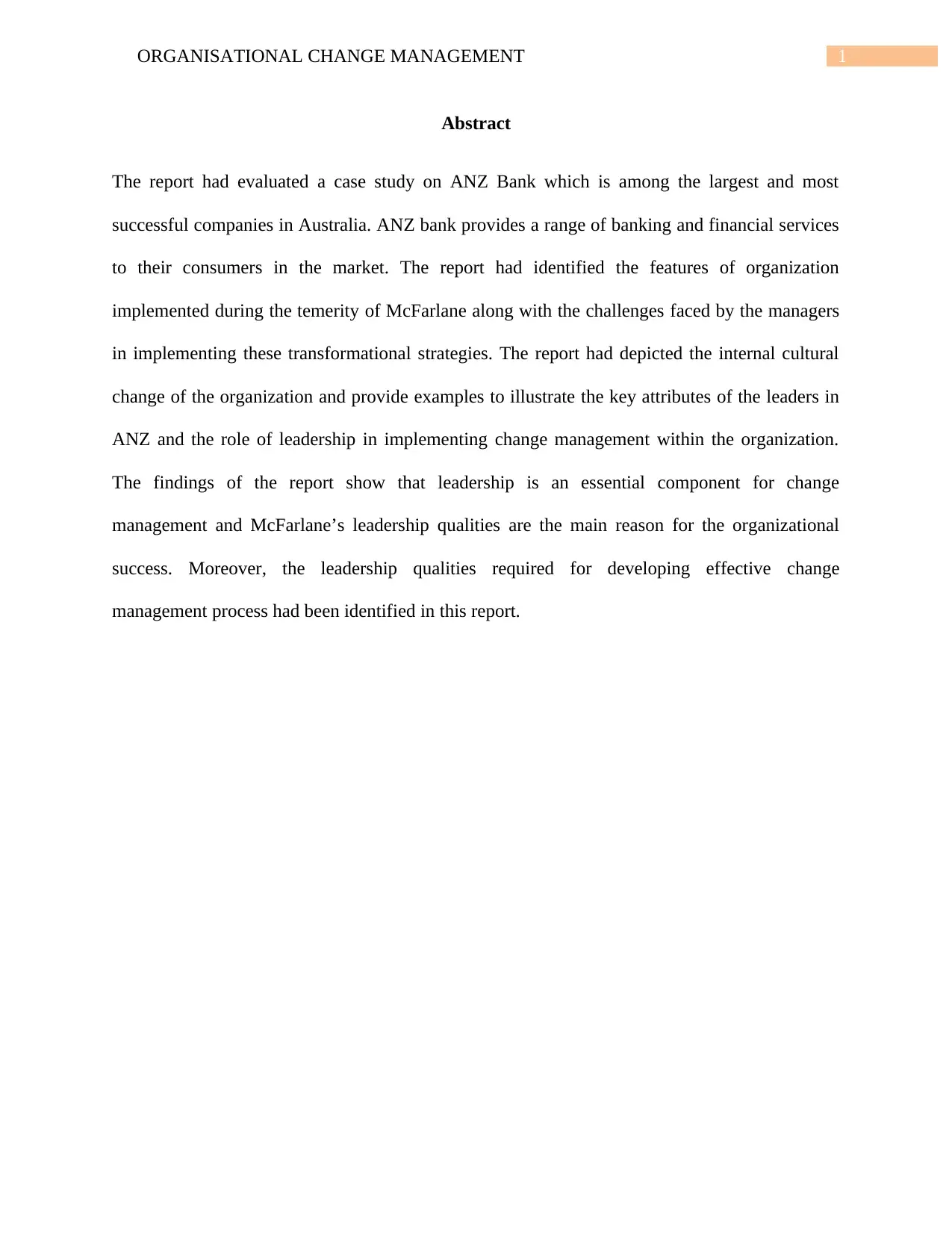
1ORGANISATIONAL CHANGE MANAGEMENT
Abstract
The report had evaluated a case study on ANZ Bank which is among the largest and most
successful companies in Australia. ANZ bank provides a range of banking and financial services
to their consumers in the market. The report had identified the features of organization
implemented during the temerity of McFarlane along with the challenges faced by the managers
in implementing these transformational strategies. The report had depicted the internal cultural
change of the organization and provide examples to illustrate the key attributes of the leaders in
ANZ and the role of leadership in implementing change management within the organization.
The findings of the report show that leadership is an essential component for change
management and McFarlane’s leadership qualities are the main reason for the organizational
success. Moreover, the leadership qualities required for developing effective change
management process had been identified in this report.
Abstract
The report had evaluated a case study on ANZ Bank which is among the largest and most
successful companies in Australia. ANZ bank provides a range of banking and financial services
to their consumers in the market. The report had identified the features of organization
implemented during the temerity of McFarlane along with the challenges faced by the managers
in implementing these transformational strategies. The report had depicted the internal cultural
change of the organization and provide examples to illustrate the key attributes of the leaders in
ANZ and the role of leadership in implementing change management within the organization.
The findings of the report show that leadership is an essential component for change
management and McFarlane’s leadership qualities are the main reason for the organizational
success. Moreover, the leadership qualities required for developing effective change
management process had been identified in this report.
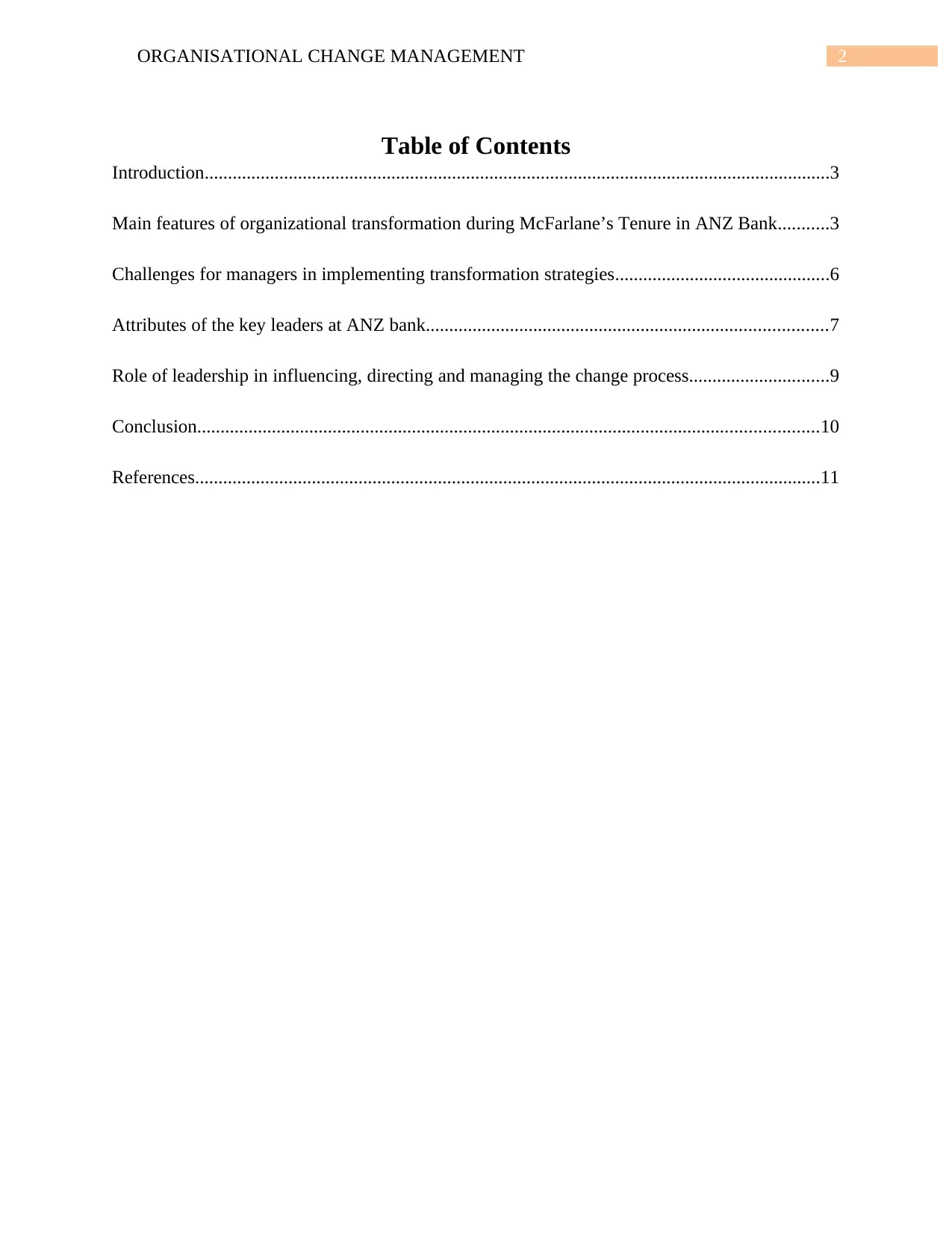
2ORGANISATIONAL CHANGE MANAGEMENT
Table of Contents
Introduction......................................................................................................................................3
Main features of organizational transformation during McFarlane’s Tenure in ANZ Bank...........3
Challenges for managers in implementing transformation strategies..............................................6
Attributes of the key leaders at ANZ bank......................................................................................7
Role of leadership in influencing, directing and managing the change process..............................9
Conclusion.....................................................................................................................................10
References......................................................................................................................................11
Table of Contents
Introduction......................................................................................................................................3
Main features of organizational transformation during McFarlane’s Tenure in ANZ Bank...........3
Challenges for managers in implementing transformation strategies..............................................6
Attributes of the key leaders at ANZ bank......................................................................................7
Role of leadership in influencing, directing and managing the change process..............................9
Conclusion.....................................................................................................................................10
References......................................................................................................................................11
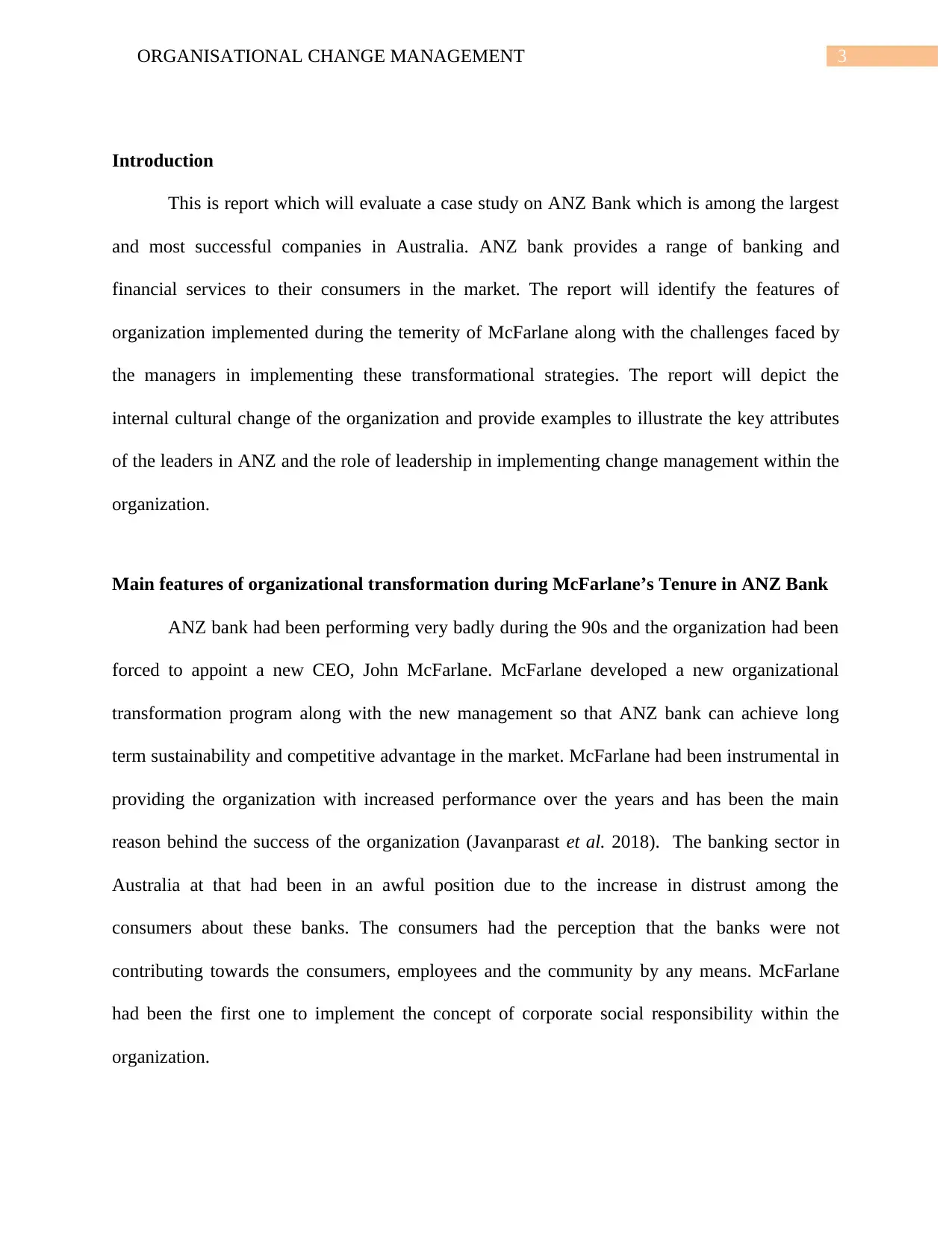
3ORGANISATIONAL CHANGE MANAGEMENT
Introduction
This is report which will evaluate a case study on ANZ Bank which is among the largest
and most successful companies in Australia. ANZ bank provides a range of banking and
financial services to their consumers in the market. The report will identify the features of
organization implemented during the temerity of McFarlane along with the challenges faced by
the managers in implementing these transformational strategies. The report will depict the
internal cultural change of the organization and provide examples to illustrate the key attributes
of the leaders in ANZ and the role of leadership in implementing change management within the
organization.
Main features of organizational transformation during McFarlane’s Tenure in ANZ Bank
ANZ bank had been performing very badly during the 90s and the organization had been
forced to appoint a new CEO, John McFarlane. McFarlane developed a new organizational
transformation program along with the new management so that ANZ bank can achieve long
term sustainability and competitive advantage in the market. McFarlane had been instrumental in
providing the organization with increased performance over the years and has been the main
reason behind the success of the organization (Javanparast et al. 2018). The banking sector in
Australia at that had been in an awful position due to the increase in distrust among the
consumers about these banks. The consumers had the perception that the banks were not
contributing towards the consumers, employees and the community by any means. McFarlane
had been the first one to implement the concept of corporate social responsibility within the
organization.
Introduction
This is report which will evaluate a case study on ANZ Bank which is among the largest
and most successful companies in Australia. ANZ bank provides a range of banking and
financial services to their consumers in the market. The report will identify the features of
organization implemented during the temerity of McFarlane along with the challenges faced by
the managers in implementing these transformational strategies. The report will depict the
internal cultural change of the organization and provide examples to illustrate the key attributes
of the leaders in ANZ and the role of leadership in implementing change management within the
organization.
Main features of organizational transformation during McFarlane’s Tenure in ANZ Bank
ANZ bank had been performing very badly during the 90s and the organization had been
forced to appoint a new CEO, John McFarlane. McFarlane developed a new organizational
transformation program along with the new management so that ANZ bank can achieve long
term sustainability and competitive advantage in the market. McFarlane had been instrumental in
providing the organization with increased performance over the years and has been the main
reason behind the success of the organization (Javanparast et al. 2018). The banking sector in
Australia at that had been in an awful position due to the increase in distrust among the
consumers about these banks. The consumers had the perception that the banks were not
contributing towards the consumers, employees and the community by any means. McFarlane
had been the first one to implement the concept of corporate social responsibility within the
organization.
Secure Best Marks with AI Grader
Need help grading? Try our AI Grader for instant feedback on your assignments.
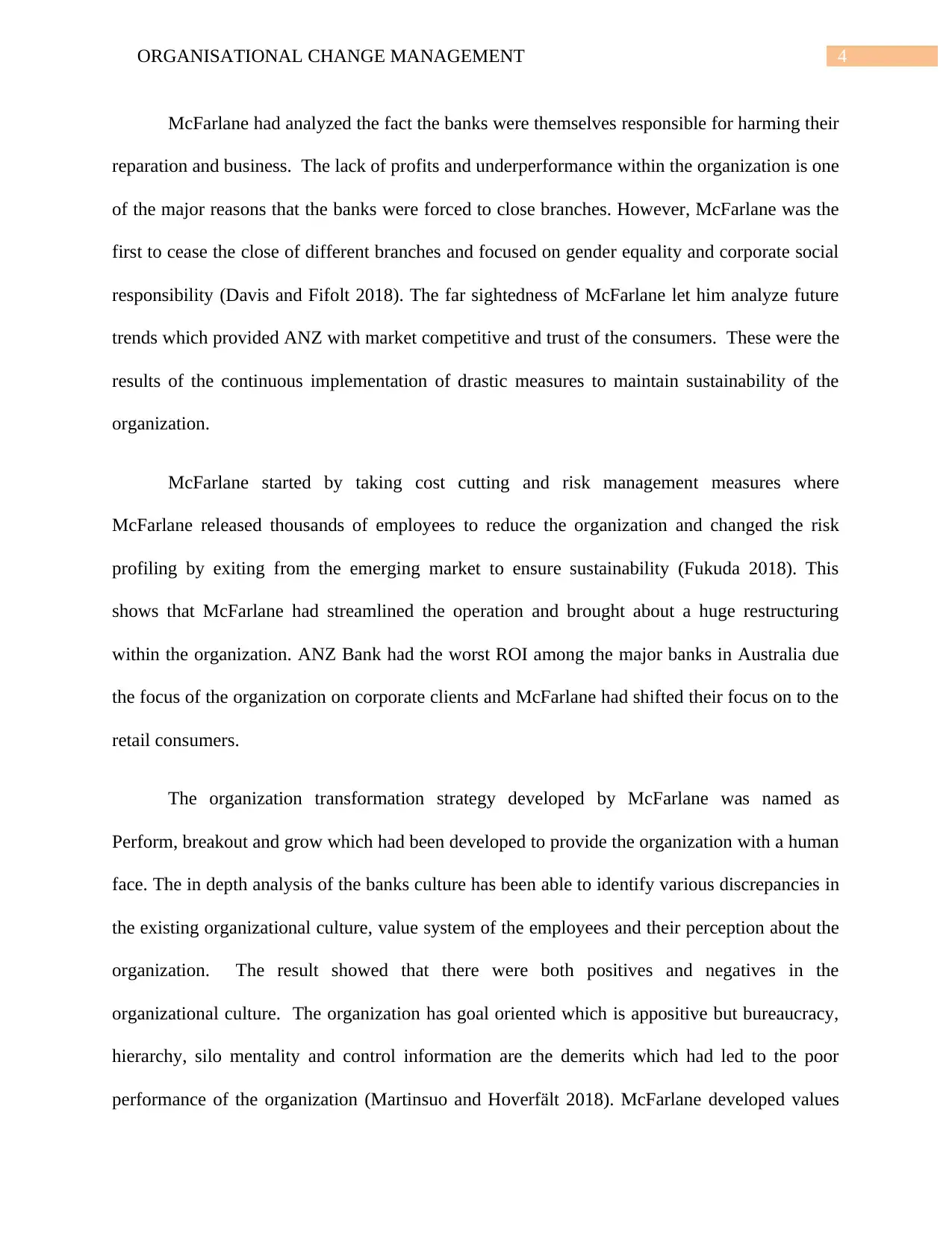
4ORGANISATIONAL CHANGE MANAGEMENT
McFarlane had analyzed the fact the banks were themselves responsible for harming their
reparation and business. The lack of profits and underperformance within the organization is one
of the major reasons that the banks were forced to close branches. However, McFarlane was the
first to cease the close of different branches and focused on gender equality and corporate social
responsibility (Davis and Fifolt 2018). The far sightedness of McFarlane let him analyze future
trends which provided ANZ with market competitive and trust of the consumers. These were the
results of the continuous implementation of drastic measures to maintain sustainability of the
organization.
McFarlane started by taking cost cutting and risk management measures where
McFarlane released thousands of employees to reduce the organization and changed the risk
profiling by exiting from the emerging market to ensure sustainability (Fukuda 2018). This
shows that McFarlane had streamlined the operation and brought about a huge restructuring
within the organization. ANZ Bank had the worst ROI among the major banks in Australia due
the focus of the organization on corporate clients and McFarlane had shifted their focus on to the
retail consumers.
The organization transformation strategy developed by McFarlane was named as
Perform, breakout and grow which had been developed to provide the organization with a human
face. The in depth analysis of the banks culture has been able to identify various discrepancies in
the existing organizational culture, value system of the employees and their perception about the
organization. The result showed that there were both positives and negatives in the
organizational culture. The organization has goal oriented which is appositive but bureaucracy,
hierarchy, silo mentality and control information are the demerits which had led to the poor
performance of the organization (Martinsuo and Hoverfält 2018). McFarlane developed values
McFarlane had analyzed the fact the banks were themselves responsible for harming their
reparation and business. The lack of profits and underperformance within the organization is one
of the major reasons that the banks were forced to close branches. However, McFarlane was the
first to cease the close of different branches and focused on gender equality and corporate social
responsibility (Davis and Fifolt 2018). The far sightedness of McFarlane let him analyze future
trends which provided ANZ with market competitive and trust of the consumers. These were the
results of the continuous implementation of drastic measures to maintain sustainability of the
organization.
McFarlane started by taking cost cutting and risk management measures where
McFarlane released thousands of employees to reduce the organization and changed the risk
profiling by exiting from the emerging market to ensure sustainability (Fukuda 2018). This
shows that McFarlane had streamlined the operation and brought about a huge restructuring
within the organization. ANZ Bank had the worst ROI among the major banks in Australia due
the focus of the organization on corporate clients and McFarlane had shifted their focus on to the
retail consumers.
The organization transformation strategy developed by McFarlane was named as
Perform, breakout and grow which had been developed to provide the organization with a human
face. The in depth analysis of the banks culture has been able to identify various discrepancies in
the existing organizational culture, value system of the employees and their perception about the
organization. The result showed that there were both positives and negatives in the
organizational culture. The organization has goal oriented which is appositive but bureaucracy,
hierarchy, silo mentality and control information are the demerits which had led to the poor
performance of the organization (Martinsuo and Hoverfält 2018). McFarlane developed values
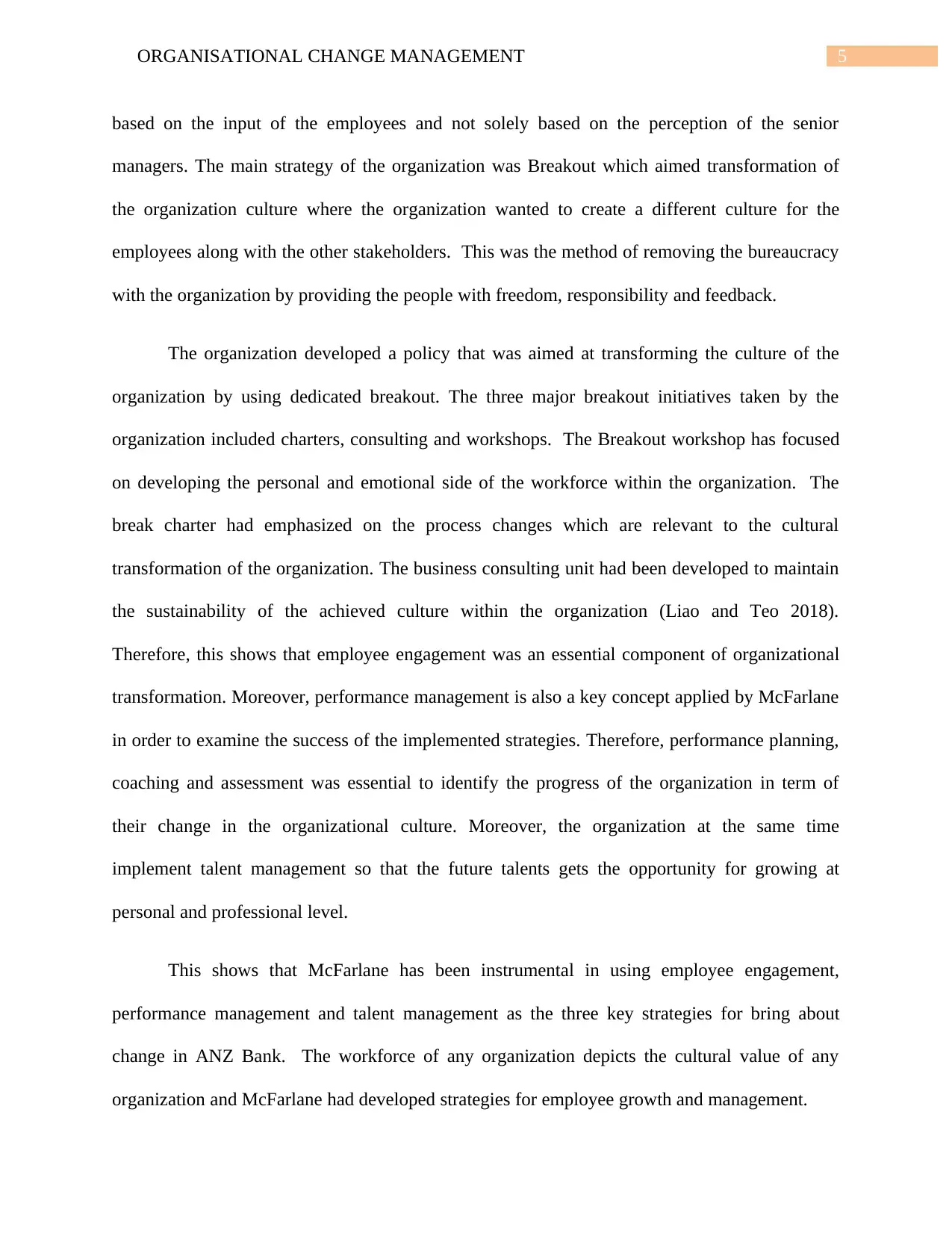
5ORGANISATIONAL CHANGE MANAGEMENT
based on the input of the employees and not solely based on the perception of the senior
managers. The main strategy of the organization was Breakout which aimed transformation of
the organization culture where the organization wanted to create a different culture for the
employees along with the other stakeholders. This was the method of removing the bureaucracy
with the organization by providing the people with freedom, responsibility and feedback.
The organization developed a policy that was aimed at transforming the culture of the
organization by using dedicated breakout. The three major breakout initiatives taken by the
organization included charters, consulting and workshops. The Breakout workshop has focused
on developing the personal and emotional side of the workforce within the organization. The
break charter had emphasized on the process changes which are relevant to the cultural
transformation of the organization. The business consulting unit had been developed to maintain
the sustainability of the achieved culture within the organization (Liao and Teo 2018).
Therefore, this shows that employee engagement was an essential component of organizational
transformation. Moreover, performance management is also a key concept applied by McFarlane
in order to examine the success of the implemented strategies. Therefore, performance planning,
coaching and assessment was essential to identify the progress of the organization in term of
their change in the organizational culture. Moreover, the organization at the same time
implement talent management so that the future talents gets the opportunity for growing at
personal and professional level.
This shows that McFarlane has been instrumental in using employee engagement,
performance management and talent management as the three key strategies for bring about
change in ANZ Bank. The workforce of any organization depicts the cultural value of any
organization and McFarlane had developed strategies for employee growth and management.
based on the input of the employees and not solely based on the perception of the senior
managers. The main strategy of the organization was Breakout which aimed transformation of
the organization culture where the organization wanted to create a different culture for the
employees along with the other stakeholders. This was the method of removing the bureaucracy
with the organization by providing the people with freedom, responsibility and feedback.
The organization developed a policy that was aimed at transforming the culture of the
organization by using dedicated breakout. The three major breakout initiatives taken by the
organization included charters, consulting and workshops. The Breakout workshop has focused
on developing the personal and emotional side of the workforce within the organization. The
break charter had emphasized on the process changes which are relevant to the cultural
transformation of the organization. The business consulting unit had been developed to maintain
the sustainability of the achieved culture within the organization (Liao and Teo 2018).
Therefore, this shows that employee engagement was an essential component of organizational
transformation. Moreover, performance management is also a key concept applied by McFarlane
in order to examine the success of the implemented strategies. Therefore, performance planning,
coaching and assessment was essential to identify the progress of the organization in term of
their change in the organizational culture. Moreover, the organization at the same time
implement talent management so that the future talents gets the opportunity for growing at
personal and professional level.
This shows that McFarlane has been instrumental in using employee engagement,
performance management and talent management as the three key strategies for bring about
change in ANZ Bank. The workforce of any organization depicts the cultural value of any
organization and McFarlane had developed strategies for employee growth and management.
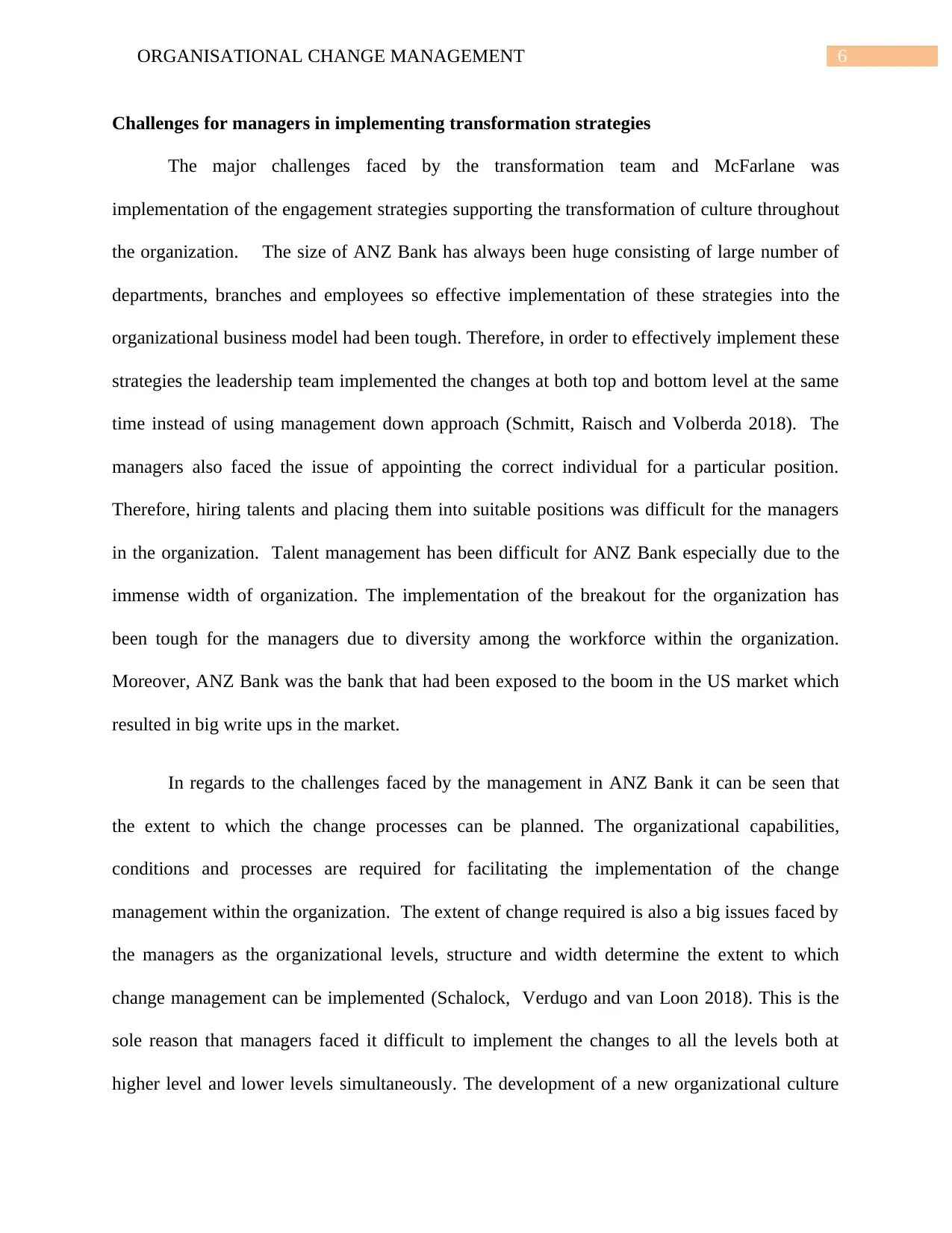
6ORGANISATIONAL CHANGE MANAGEMENT
Challenges for managers in implementing transformation strategies
The major challenges faced by the transformation team and McFarlane was
implementation of the engagement strategies supporting the transformation of culture throughout
the organization. The size of ANZ Bank has always been huge consisting of large number of
departments, branches and employees so effective implementation of these strategies into the
organizational business model had been tough. Therefore, in order to effectively implement these
strategies the leadership team implemented the changes at both top and bottom level at the same
time instead of using management down approach (Schmitt, Raisch and Volberda 2018). The
managers also faced the issue of appointing the correct individual for a particular position.
Therefore, hiring talents and placing them into suitable positions was difficult for the managers
in the organization. Talent management has been difficult for ANZ Bank especially due to the
immense width of organization. The implementation of the breakout for the organization has
been tough for the managers due to diversity among the workforce within the organization.
Moreover, ANZ Bank was the bank that had been exposed to the boom in the US market which
resulted in big write ups in the market.
In regards to the challenges faced by the management in ANZ Bank it can be seen that
the extent to which the change processes can be planned. The organizational capabilities,
conditions and processes are required for facilitating the implementation of the change
management within the organization. The extent of change required is also a big issues faced by
the managers as the organizational levels, structure and width determine the extent to which
change management can be implemented (Schalock, Verdugo and van Loon 2018). This is the
sole reason that managers faced it difficult to implement the changes to all the levels both at
higher level and lower levels simultaneously. The development of a new organizational culture
Challenges for managers in implementing transformation strategies
The major challenges faced by the transformation team and McFarlane was
implementation of the engagement strategies supporting the transformation of culture throughout
the organization. The size of ANZ Bank has always been huge consisting of large number of
departments, branches and employees so effective implementation of these strategies into the
organizational business model had been tough. Therefore, in order to effectively implement these
strategies the leadership team implemented the changes at both top and bottom level at the same
time instead of using management down approach (Schmitt, Raisch and Volberda 2018). The
managers also faced the issue of appointing the correct individual for a particular position.
Therefore, hiring talents and placing them into suitable positions was difficult for the managers
in the organization. Talent management has been difficult for ANZ Bank especially due to the
immense width of organization. The implementation of the breakout for the organization has
been tough for the managers due to diversity among the workforce within the organization.
Moreover, ANZ Bank was the bank that had been exposed to the boom in the US market which
resulted in big write ups in the market.
In regards to the challenges faced by the management in ANZ Bank it can be seen that
the extent to which the change processes can be planned. The organizational capabilities,
conditions and processes are required for facilitating the implementation of the change
management within the organization. The extent of change required is also a big issues faced by
the managers as the organizational levels, structure and width determine the extent to which
change management can be implemented (Schalock, Verdugo and van Loon 2018). This is the
sole reason that managers faced it difficult to implement the changes to all the levels both at
higher level and lower levels simultaneously. The development of a new organizational culture
Paraphrase This Document
Need a fresh take? Get an instant paraphrase of this document with our AI Paraphraser
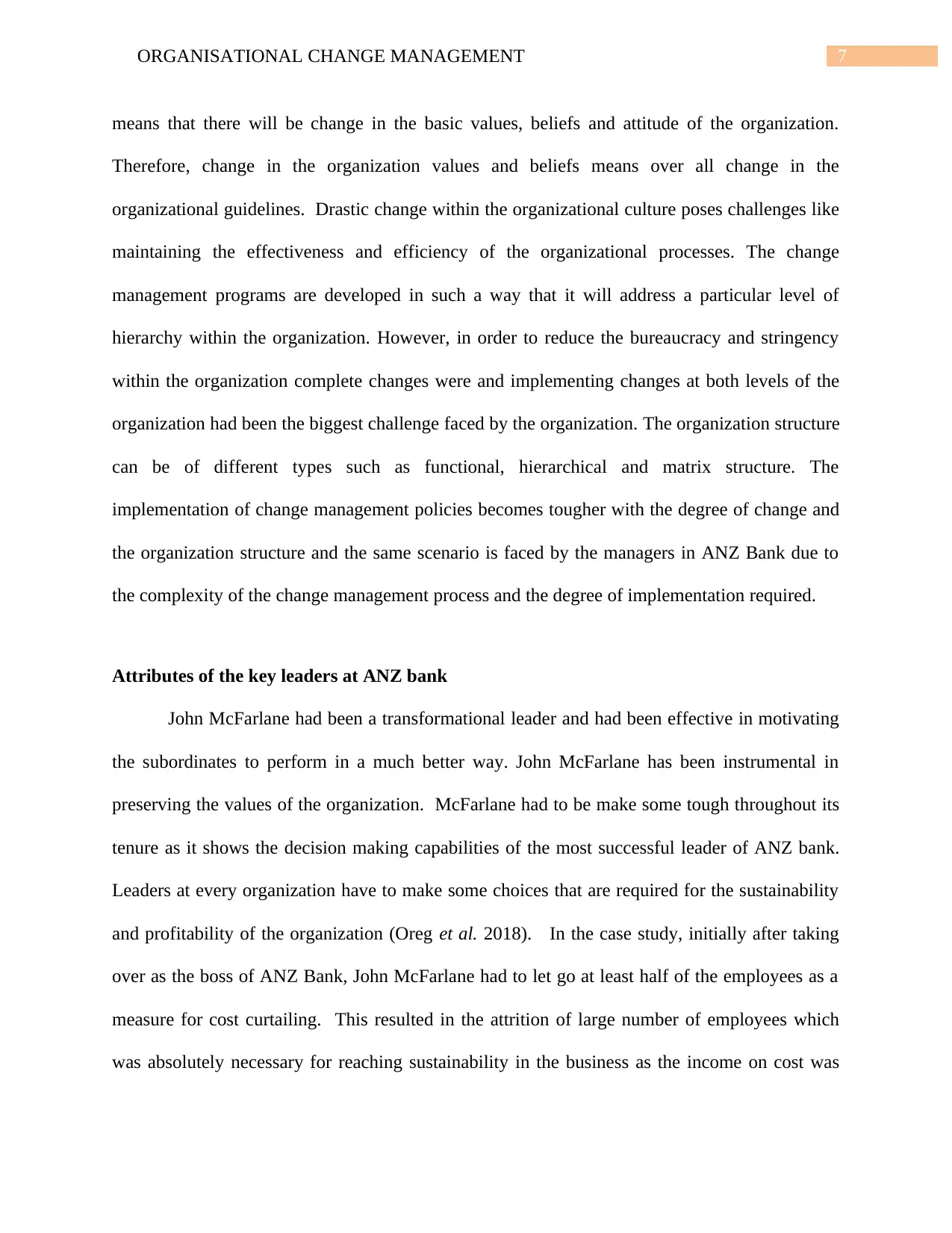
7ORGANISATIONAL CHANGE MANAGEMENT
means that there will be change in the basic values, beliefs and attitude of the organization.
Therefore, change in the organization values and beliefs means over all change in the
organizational guidelines. Drastic change within the organizational culture poses challenges like
maintaining the effectiveness and efficiency of the organizational processes. The change
management programs are developed in such a way that it will address a particular level of
hierarchy within the organization. However, in order to reduce the bureaucracy and stringency
within the organization complete changes were and implementing changes at both levels of the
organization had been the biggest challenge faced by the organization. The organization structure
can be of different types such as functional, hierarchical and matrix structure. The
implementation of change management policies becomes tougher with the degree of change and
the organization structure and the same scenario is faced by the managers in ANZ Bank due to
the complexity of the change management process and the degree of implementation required.
Attributes of the key leaders at ANZ bank
John McFarlane had been a transformational leader and had been effective in motivating
the subordinates to perform in a much better way. John McFarlane has been instrumental in
preserving the values of the organization. McFarlane had to be make some tough throughout its
tenure as it shows the decision making capabilities of the most successful leader of ANZ bank.
Leaders at every organization have to make some choices that are required for the sustainability
and profitability of the organization (Oreg et al. 2018). In the case study, initially after taking
over as the boss of ANZ Bank, John McFarlane had to let go at least half of the employees as a
measure for cost curtailing. This resulted in the attrition of large number of employees which
was absolutely necessary for reaching sustainability in the business as the income on cost was
means that there will be change in the basic values, beliefs and attitude of the organization.
Therefore, change in the organization values and beliefs means over all change in the
organizational guidelines. Drastic change within the organizational culture poses challenges like
maintaining the effectiveness and efficiency of the organizational processes. The change
management programs are developed in such a way that it will address a particular level of
hierarchy within the organization. However, in order to reduce the bureaucracy and stringency
within the organization complete changes were and implementing changes at both levels of the
organization had been the biggest challenge faced by the organization. The organization structure
can be of different types such as functional, hierarchical and matrix structure. The
implementation of change management policies becomes tougher with the degree of change and
the organization structure and the same scenario is faced by the managers in ANZ Bank due to
the complexity of the change management process and the degree of implementation required.
Attributes of the key leaders at ANZ bank
John McFarlane had been a transformational leader and had been effective in motivating
the subordinates to perform in a much better way. John McFarlane has been instrumental in
preserving the values of the organization. McFarlane had to be make some tough throughout its
tenure as it shows the decision making capabilities of the most successful leader of ANZ bank.
Leaders at every organization have to make some choices that are required for the sustainability
and profitability of the organization (Oreg et al. 2018). In the case study, initially after taking
over as the boss of ANZ Bank, John McFarlane had to let go at least half of the employees as a
measure for cost curtailing. This resulted in the attrition of large number of employees which
was absolutely necessary for reaching sustainability in the business as the income on cost was
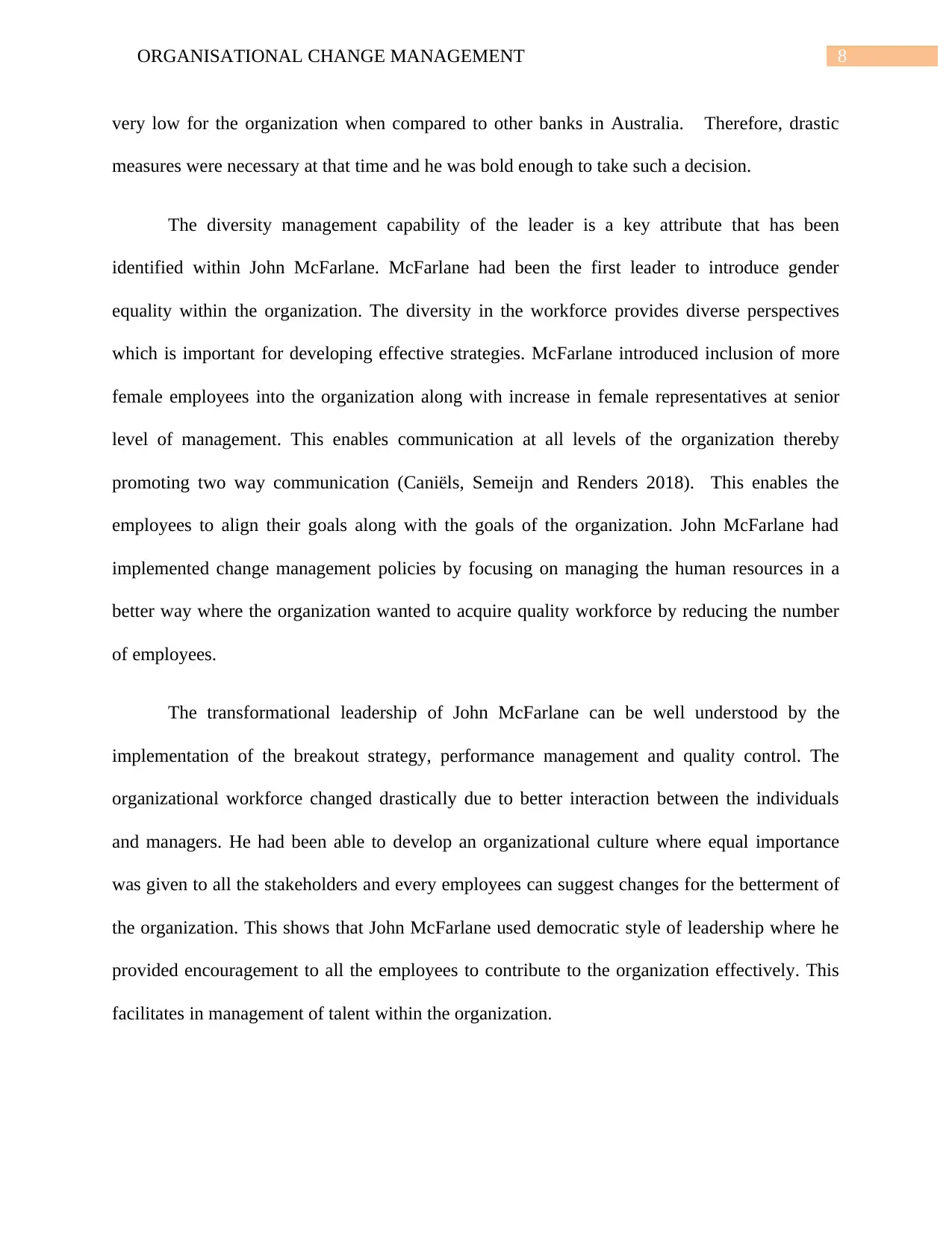
8ORGANISATIONAL CHANGE MANAGEMENT
very low for the organization when compared to other banks in Australia. Therefore, drastic
measures were necessary at that time and he was bold enough to take such a decision.
The diversity management capability of the leader is a key attribute that has been
identified within John McFarlane. McFarlane had been the first leader to introduce gender
equality within the organization. The diversity in the workforce provides diverse perspectives
which is important for developing effective strategies. McFarlane introduced inclusion of more
female employees into the organization along with increase in female representatives at senior
level of management. This enables communication at all levels of the organization thereby
promoting two way communication (Caniëls, Semeijn and Renders 2018). This enables the
employees to align their goals along with the goals of the organization. John McFarlane had
implemented change management policies by focusing on managing the human resources in a
better way where the organization wanted to acquire quality workforce by reducing the number
of employees.
The transformational leadership of John McFarlane can be well understood by the
implementation of the breakout strategy, performance management and quality control. The
organizational workforce changed drastically due to better interaction between the individuals
and managers. He had been able to develop an organizational culture where equal importance
was given to all the stakeholders and every employees can suggest changes for the betterment of
the organization. This shows that John McFarlane used democratic style of leadership where he
provided encouragement to all the employees to contribute to the organization effectively. This
facilitates in management of talent within the organization.
very low for the organization when compared to other banks in Australia. Therefore, drastic
measures were necessary at that time and he was bold enough to take such a decision.
The diversity management capability of the leader is a key attribute that has been
identified within John McFarlane. McFarlane had been the first leader to introduce gender
equality within the organization. The diversity in the workforce provides diverse perspectives
which is important for developing effective strategies. McFarlane introduced inclusion of more
female employees into the organization along with increase in female representatives at senior
level of management. This enables communication at all levels of the organization thereby
promoting two way communication (Caniëls, Semeijn and Renders 2018). This enables the
employees to align their goals along with the goals of the organization. John McFarlane had
implemented change management policies by focusing on managing the human resources in a
better way where the organization wanted to acquire quality workforce by reducing the number
of employees.
The transformational leadership of John McFarlane can be well understood by the
implementation of the breakout strategy, performance management and quality control. The
organizational workforce changed drastically due to better interaction between the individuals
and managers. He had been able to develop an organizational culture where equal importance
was given to all the stakeholders and every employees can suggest changes for the betterment of
the organization. This shows that John McFarlane used democratic style of leadership where he
provided encouragement to all the employees to contribute to the organization effectively. This
facilitates in management of talent within the organization.
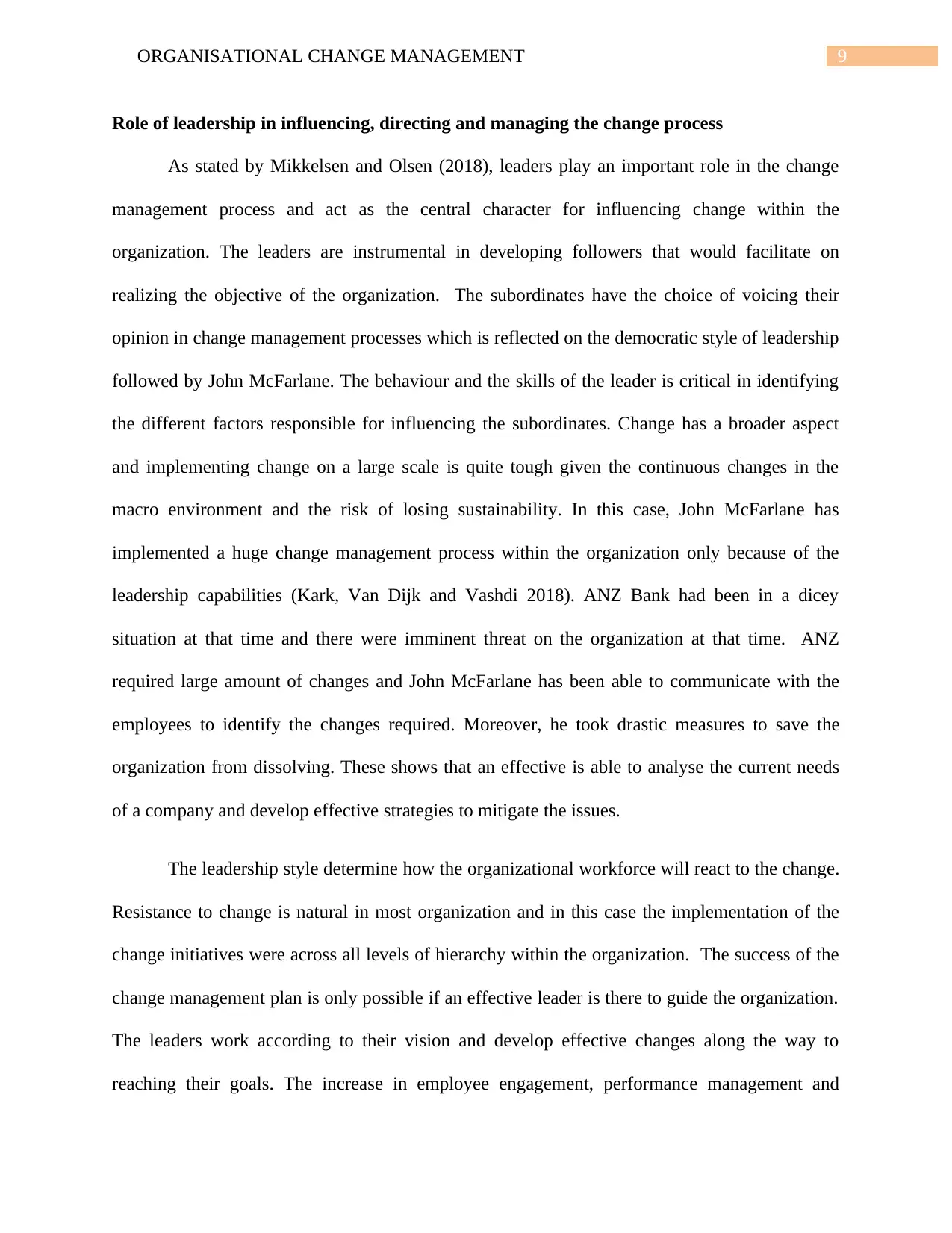
9ORGANISATIONAL CHANGE MANAGEMENT
Role of leadership in influencing, directing and managing the change process
As stated by Mikkelsen and Olsen (2018), leaders play an important role in the change
management process and act as the central character for influencing change within the
organization. The leaders are instrumental in developing followers that would facilitate on
realizing the objective of the organization. The subordinates have the choice of voicing their
opinion in change management processes which is reflected on the democratic style of leadership
followed by John McFarlane. The behaviour and the skills of the leader is critical in identifying
the different factors responsible for influencing the subordinates. Change has a broader aspect
and implementing change on a large scale is quite tough given the continuous changes in the
macro environment and the risk of losing sustainability. In this case, John McFarlane has
implemented a huge change management process within the organization only because of the
leadership capabilities (Kark, Van Dijk and Vashdi 2018). ANZ Bank had been in a dicey
situation at that time and there were imminent threat on the organization at that time. ANZ
required large amount of changes and John McFarlane has been able to communicate with the
employees to identify the changes required. Moreover, he took drastic measures to save the
organization from dissolving. These shows that an effective is able to analyse the current needs
of a company and develop effective strategies to mitigate the issues.
The leadership style determine how the organizational workforce will react to the change.
Resistance to change is natural in most organization and in this case the implementation of the
change initiatives were across all levels of hierarchy within the organization. The success of the
change management plan is only possible if an effective leader is there to guide the organization.
The leaders work according to their vision and develop effective changes along the way to
reaching their goals. The increase in employee engagement, performance management and
Role of leadership in influencing, directing and managing the change process
As stated by Mikkelsen and Olsen (2018), leaders play an important role in the change
management process and act as the central character for influencing change within the
organization. The leaders are instrumental in developing followers that would facilitate on
realizing the objective of the organization. The subordinates have the choice of voicing their
opinion in change management processes which is reflected on the democratic style of leadership
followed by John McFarlane. The behaviour and the skills of the leader is critical in identifying
the different factors responsible for influencing the subordinates. Change has a broader aspect
and implementing change on a large scale is quite tough given the continuous changes in the
macro environment and the risk of losing sustainability. In this case, John McFarlane has
implemented a huge change management process within the organization only because of the
leadership capabilities (Kark, Van Dijk and Vashdi 2018). ANZ Bank had been in a dicey
situation at that time and there were imminent threat on the organization at that time. ANZ
required large amount of changes and John McFarlane has been able to communicate with the
employees to identify the changes required. Moreover, he took drastic measures to save the
organization from dissolving. These shows that an effective is able to analyse the current needs
of a company and develop effective strategies to mitigate the issues.
The leadership style determine how the organizational workforce will react to the change.
Resistance to change is natural in most organization and in this case the implementation of the
change initiatives were across all levels of hierarchy within the organization. The success of the
change management plan is only possible if an effective leader is there to guide the organization.
The leaders work according to their vision and develop effective changes along the way to
reaching their goals. The increase in employee engagement, performance management and
Secure Best Marks with AI Grader
Need help grading? Try our AI Grader for instant feedback on your assignments.
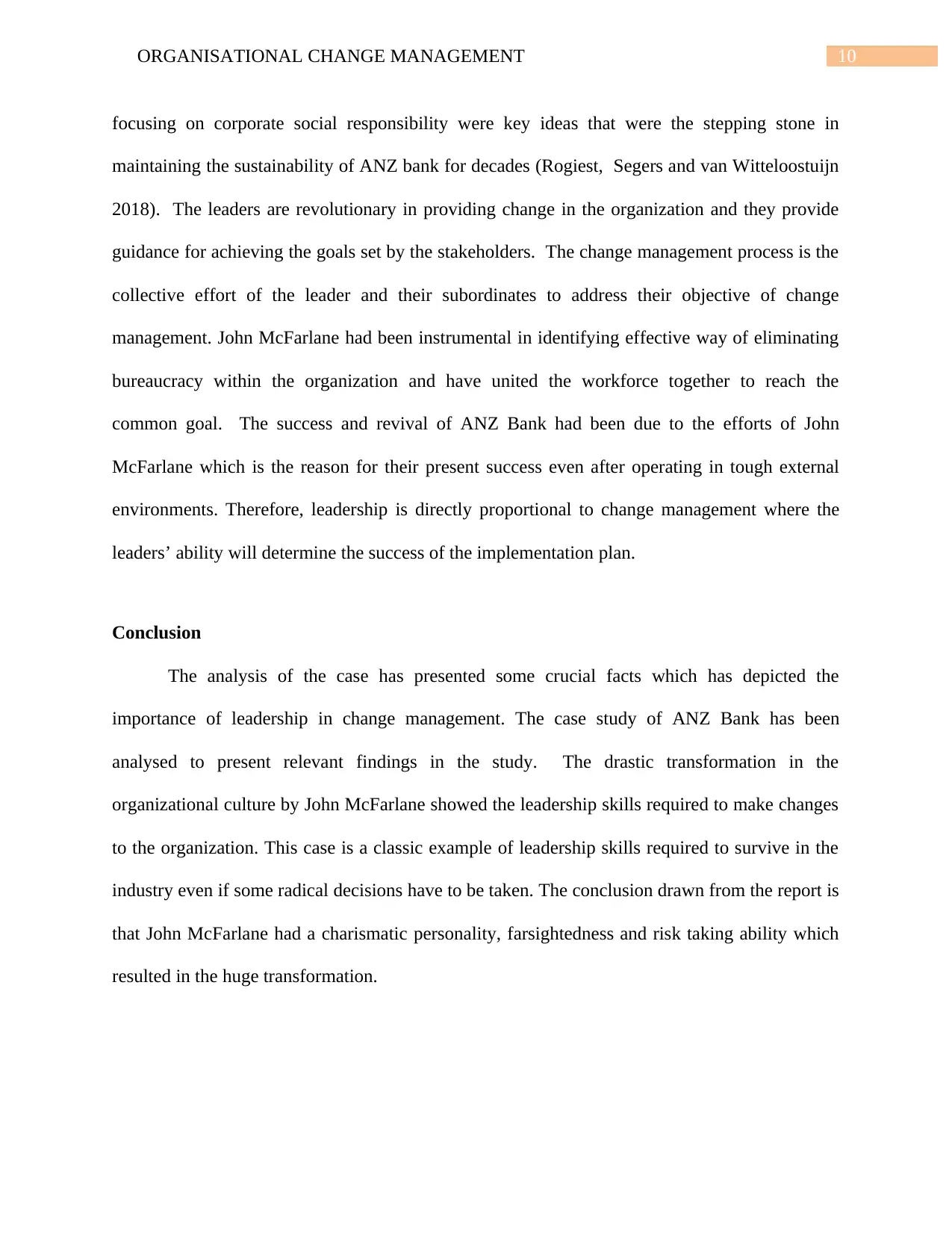
10ORGANISATIONAL CHANGE MANAGEMENT
focusing on corporate social responsibility were key ideas that were the stepping stone in
maintaining the sustainability of ANZ bank for decades (Rogiest, Segers and van Witteloostuijn
2018). The leaders are revolutionary in providing change in the organization and they provide
guidance for achieving the goals set by the stakeholders. The change management process is the
collective effort of the leader and their subordinates to address their objective of change
management. John McFarlane had been instrumental in identifying effective way of eliminating
bureaucracy within the organization and have united the workforce together to reach the
common goal. The success and revival of ANZ Bank had been due to the efforts of John
McFarlane which is the reason for their present success even after operating in tough external
environments. Therefore, leadership is directly proportional to change management where the
leaders’ ability will determine the success of the implementation plan.
Conclusion
The analysis of the case has presented some crucial facts which has depicted the
importance of leadership in change management. The case study of ANZ Bank has been
analysed to present relevant findings in the study. The drastic transformation in the
organizational culture by John McFarlane showed the leadership skills required to make changes
to the organization. This case is a classic example of leadership skills required to survive in the
industry even if some radical decisions have to be taken. The conclusion drawn from the report is
that John McFarlane had a charismatic personality, farsightedness and risk taking ability which
resulted in the huge transformation.
focusing on corporate social responsibility were key ideas that were the stepping stone in
maintaining the sustainability of ANZ bank for decades (Rogiest, Segers and van Witteloostuijn
2018). The leaders are revolutionary in providing change in the organization and they provide
guidance for achieving the goals set by the stakeholders. The change management process is the
collective effort of the leader and their subordinates to address their objective of change
management. John McFarlane had been instrumental in identifying effective way of eliminating
bureaucracy within the organization and have united the workforce together to reach the
common goal. The success and revival of ANZ Bank had been due to the efforts of John
McFarlane which is the reason for their present success even after operating in tough external
environments. Therefore, leadership is directly proportional to change management where the
leaders’ ability will determine the success of the implementation plan.
Conclusion
The analysis of the case has presented some crucial facts which has depicted the
importance of leadership in change management. The case study of ANZ Bank has been
analysed to present relevant findings in the study. The drastic transformation in the
organizational culture by John McFarlane showed the leadership skills required to make changes
to the organization. This case is a classic example of leadership skills required to survive in the
industry even if some radical decisions have to be taken. The conclusion drawn from the report is
that John McFarlane had a charismatic personality, farsightedness and risk taking ability which
resulted in the huge transformation.
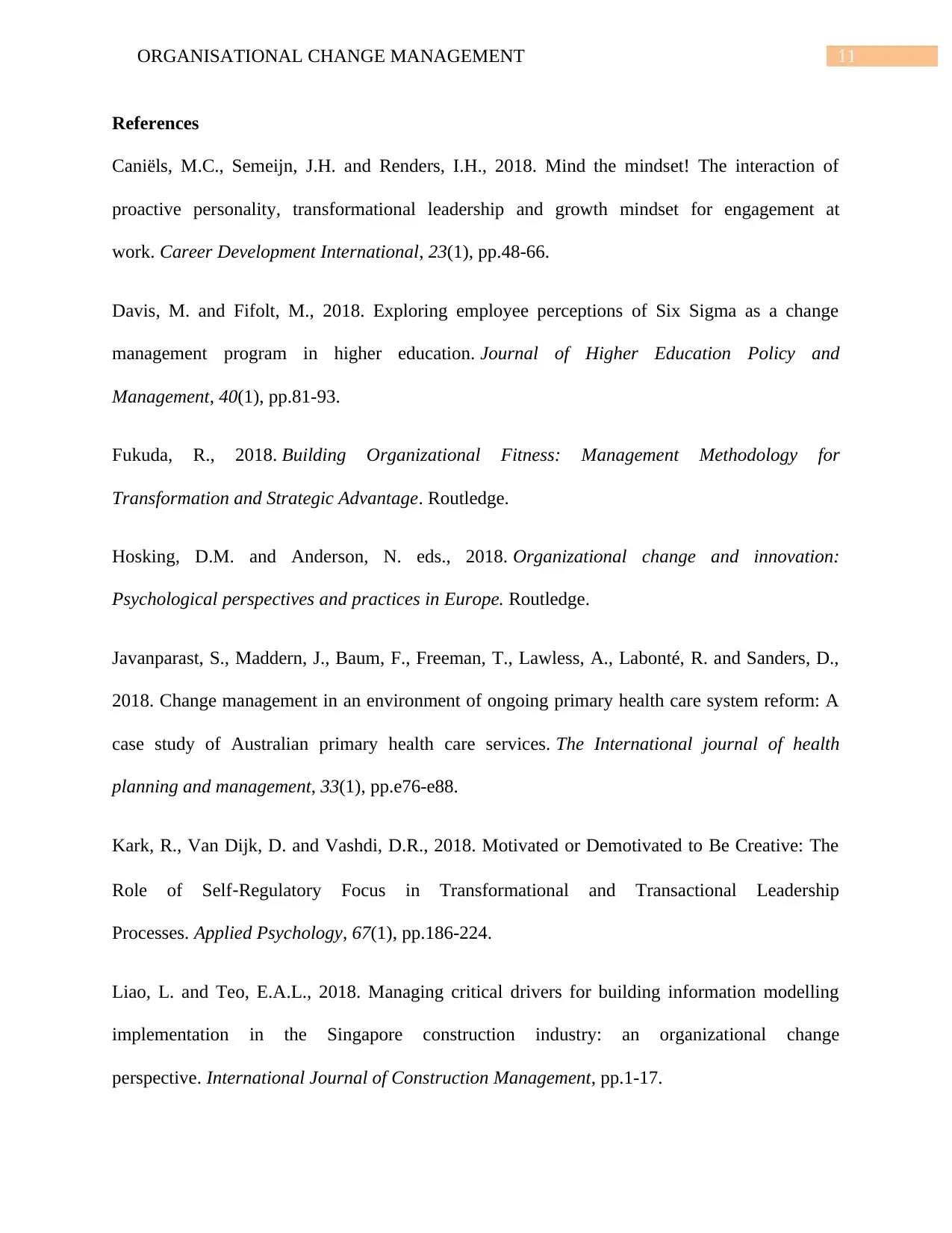
11ORGANISATIONAL CHANGE MANAGEMENT
References
Caniëls, M.C., Semeijn, J.H. and Renders, I.H., 2018. Mind the mindset! The interaction of
proactive personality, transformational leadership and growth mindset for engagement at
work. Career Development International, 23(1), pp.48-66.
Davis, M. and Fifolt, M., 2018. Exploring employee perceptions of Six Sigma as a change
management program in higher education. Journal of Higher Education Policy and
Management, 40(1), pp.81-93.
Fukuda, R., 2018. Building Organizational Fitness: Management Methodology for
Transformation and Strategic Advantage. Routledge.
Hosking, D.M. and Anderson, N. eds., 2018. Organizational change and innovation:
Psychological perspectives and practices in Europe. Routledge.
Javanparast, S., Maddern, J., Baum, F., Freeman, T., Lawless, A., Labonté, R. and Sanders, D.,
2018. Change management in an environment of ongoing primary health care system reform: A
case study of Australian primary health care services. The International journal of health
planning and management, 33(1), pp.e76-e88.
Kark, R., Van Dijk, D. and Vashdi, D.R., 2018. Motivated or Demotivated to Be Creative: The
Role of Self‐Regulatory Focus in Transformational and Transactional Leadership
Processes. Applied Psychology, 67(1), pp.186-224.
Liao, L. and Teo, E.A.L., 2018. Managing critical drivers for building information modelling
implementation in the Singapore construction industry: an organizational change
perspective. International Journal of Construction Management, pp.1-17.
References
Caniëls, M.C., Semeijn, J.H. and Renders, I.H., 2018. Mind the mindset! The interaction of
proactive personality, transformational leadership and growth mindset for engagement at
work. Career Development International, 23(1), pp.48-66.
Davis, M. and Fifolt, M., 2018. Exploring employee perceptions of Six Sigma as a change
management program in higher education. Journal of Higher Education Policy and
Management, 40(1), pp.81-93.
Fukuda, R., 2018. Building Organizational Fitness: Management Methodology for
Transformation and Strategic Advantage. Routledge.
Hosking, D.M. and Anderson, N. eds., 2018. Organizational change and innovation:
Psychological perspectives and practices in Europe. Routledge.
Javanparast, S., Maddern, J., Baum, F., Freeman, T., Lawless, A., Labonté, R. and Sanders, D.,
2018. Change management in an environment of ongoing primary health care system reform: A
case study of Australian primary health care services. The International journal of health
planning and management, 33(1), pp.e76-e88.
Kark, R., Van Dijk, D. and Vashdi, D.R., 2018. Motivated or Demotivated to Be Creative: The
Role of Self‐Regulatory Focus in Transformational and Transactional Leadership
Processes. Applied Psychology, 67(1), pp.186-224.
Liao, L. and Teo, E.A.L., 2018. Managing critical drivers for building information modelling
implementation in the Singapore construction industry: an organizational change
perspective. International Journal of Construction Management, pp.1-17.

12ORGANISATIONAL CHANGE MANAGEMENT
Martinsuo, M. and Hoverfält, P., 2018. Change program management: Toward a capability for
managing value-oriented, integrated multi-project change in its context. International Journal of
Project Management, 36(1), pp.134-146.
Mikkelsen, A. and Olsen, E., 2018. The influence of change-oriented leadership on work
performance and job satisfaction in hospitals–the mediating roles of learning demands and job
involvement. Leadership in Health Services.
Oreg, S., Bartunek, J.M., Lee, G. and Do, B., 2018. An affect-based model of recipients’
responses to organizational change events. Academy of Management Review, 43(1), pp.65-86.
Rogiest, S., Segers, J. and van Witteloostuijn, A., 2018. Matchmaking in organizational change:
Does every employee value participatory leadership? An empirical study. Scandinavian Journal
of Management, 34(1), pp.1-8.
Schalock, R.L., Verdugo, M.A. and van Loon, J., 2018. Understanding organization
transformation in evaluation and program planning. Evaluation and program planning, 67,
pp.53-60.
Schmitt, A., Raisch, S. and Volberda, H.W., 2018. Strategic renewal: past research, theoretical
tensions and future challenges. International Journal of Management Reviews, 20(1), pp.81-98.
Martinsuo, M. and Hoverfält, P., 2018. Change program management: Toward a capability for
managing value-oriented, integrated multi-project change in its context. International Journal of
Project Management, 36(1), pp.134-146.
Mikkelsen, A. and Olsen, E., 2018. The influence of change-oriented leadership on work
performance and job satisfaction in hospitals–the mediating roles of learning demands and job
involvement. Leadership in Health Services.
Oreg, S., Bartunek, J.M., Lee, G. and Do, B., 2018. An affect-based model of recipients’
responses to organizational change events. Academy of Management Review, 43(1), pp.65-86.
Rogiest, S., Segers, J. and van Witteloostuijn, A., 2018. Matchmaking in organizational change:
Does every employee value participatory leadership? An empirical study. Scandinavian Journal
of Management, 34(1), pp.1-8.
Schalock, R.L., Verdugo, M.A. and van Loon, J., 2018. Understanding organization
transformation in evaluation and program planning. Evaluation and program planning, 67,
pp.53-60.
Schmitt, A., Raisch, S. and Volberda, H.W., 2018. Strategic renewal: past research, theoretical
tensions and future challenges. International Journal of Management Reviews, 20(1), pp.81-98.
1 out of 13
Related Documents
Your All-in-One AI-Powered Toolkit for Academic Success.
+13062052269
info@desklib.com
Available 24*7 on WhatsApp / Email
![[object Object]](/_next/static/media/star-bottom.7253800d.svg)
Unlock your academic potential
© 2024 | Zucol Services PVT LTD | All rights reserved.





